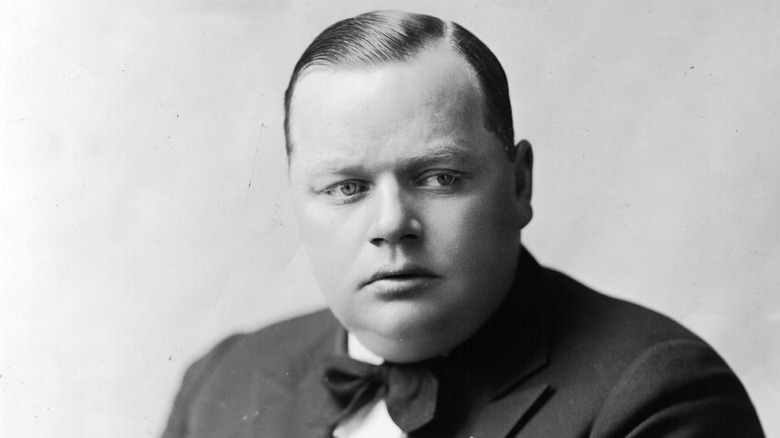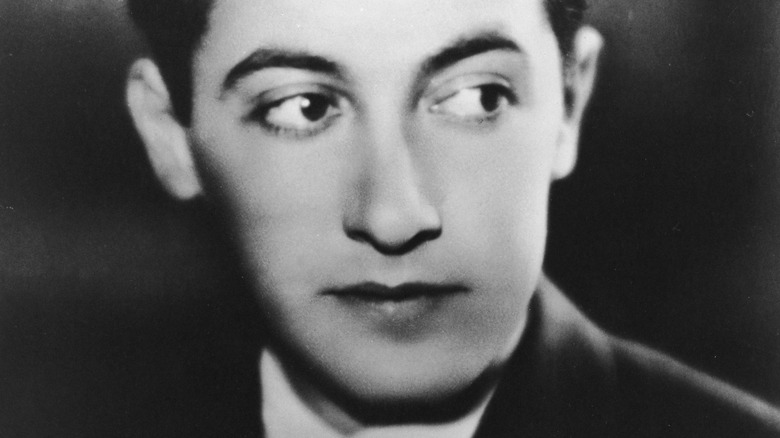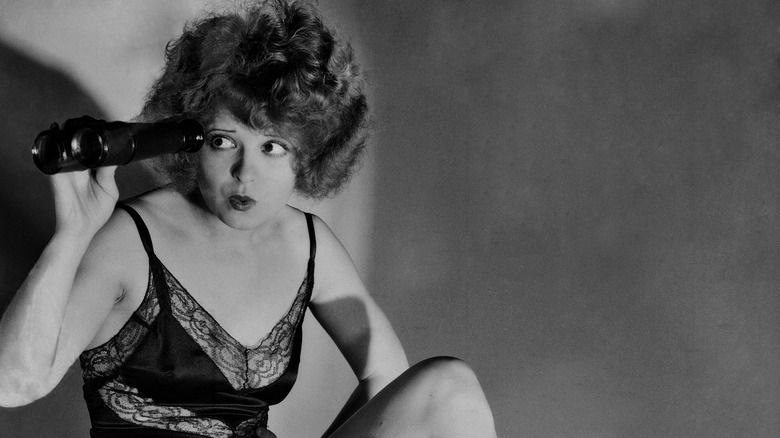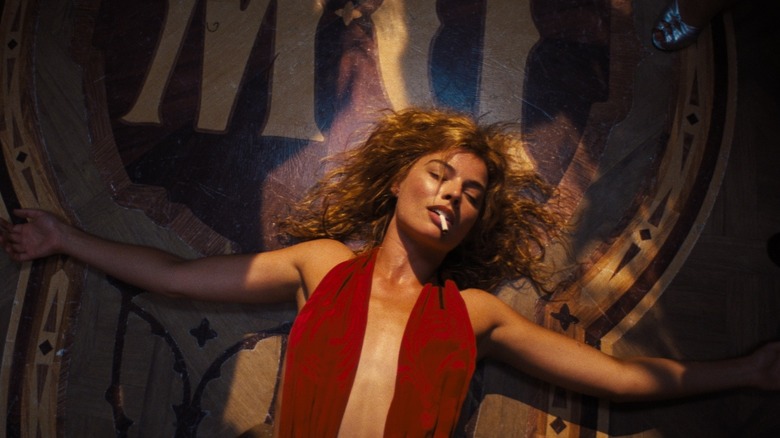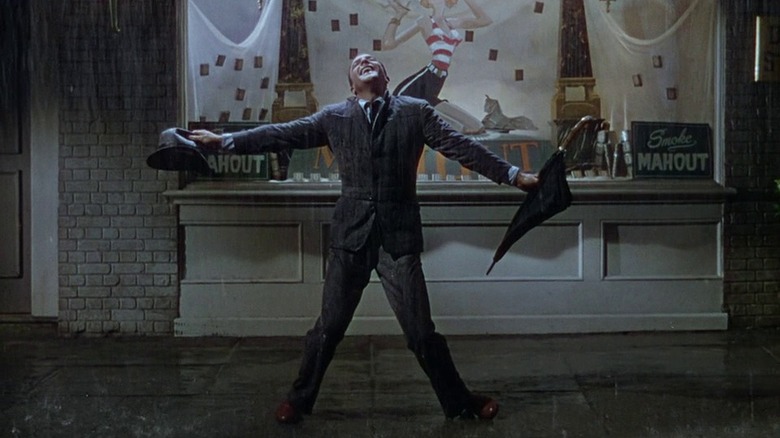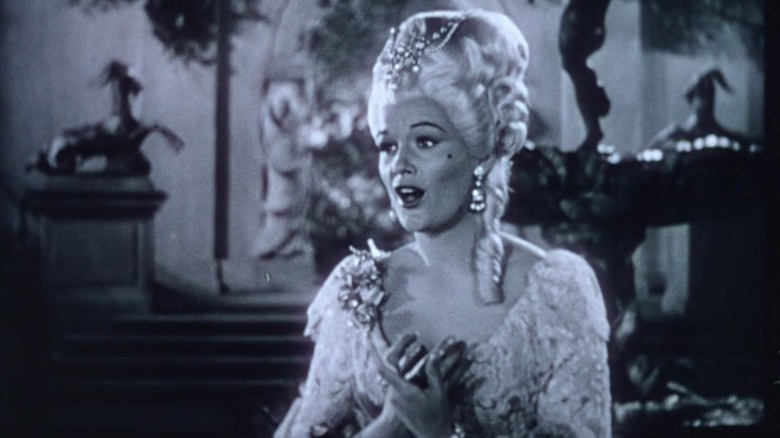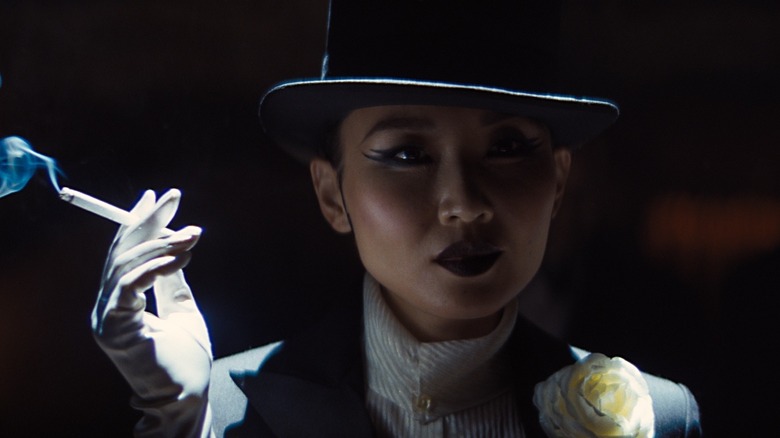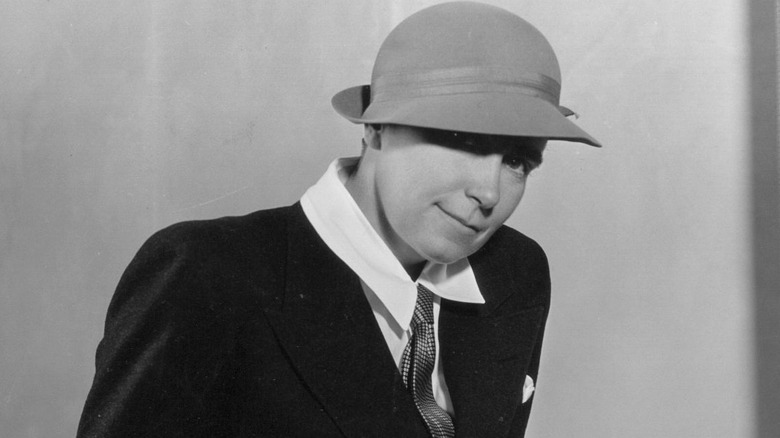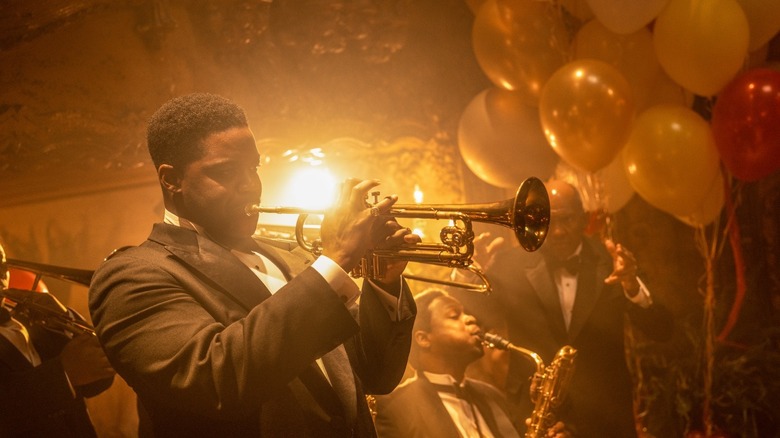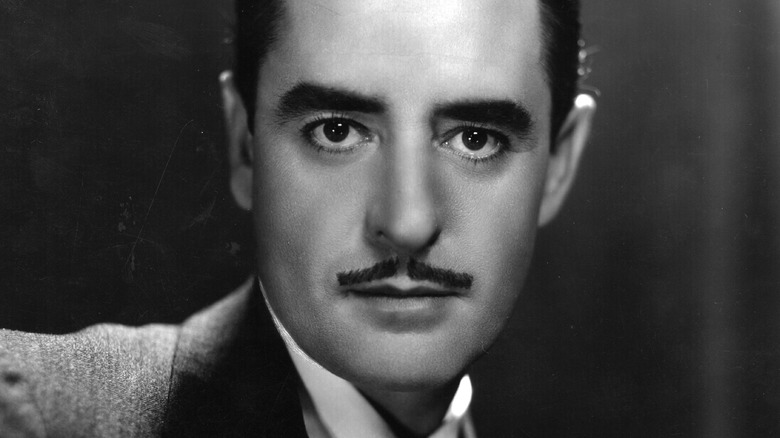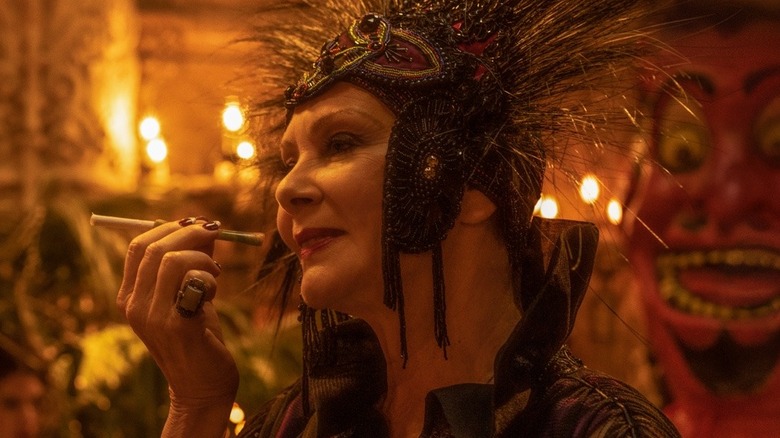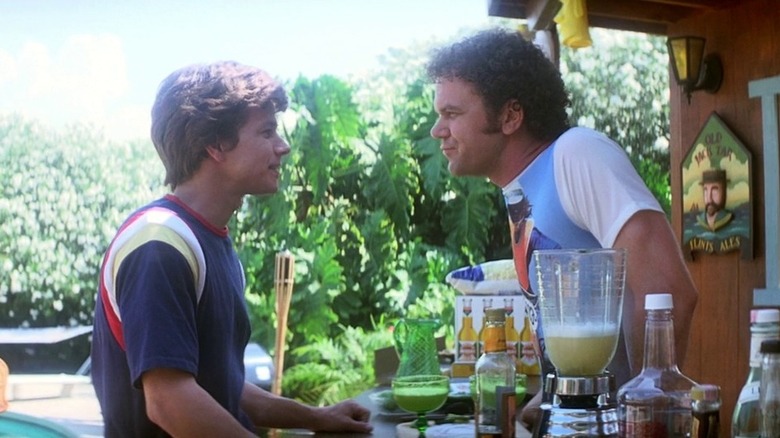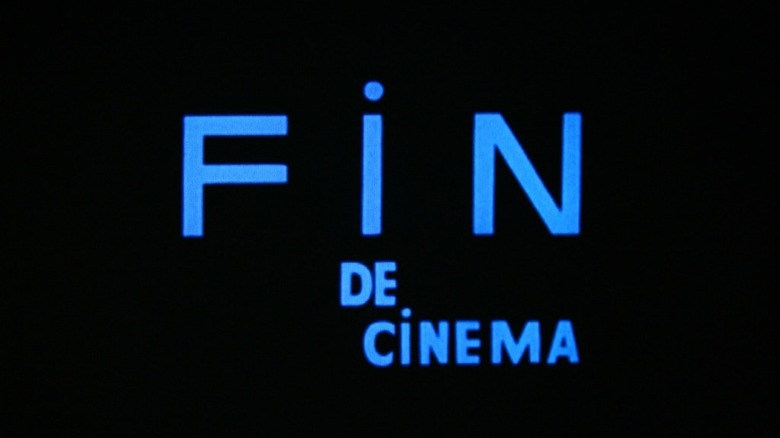Small Details And References You Missed In Babylon
"Babylon" — directed by Damien Chazelle — is a movie of elephantine proportions. Its reported production budget reached over $80 million, its runtime extends over three hours, and its ending features one of the biggest swings from a storyteller in recent years (critics remain divided whether it was a miss or not).
The movie revolves around different characters making their way through the early Wild West days of Hollywood as the movie business transitions from silent film to talkies. It follows an actor at the top of his game played by Brad Pitt, an up-and-coming movie executive played by Diego Calva, a rising starlet played by Margot Robbie, and many more. Their shared pursuit of fame and fortune in the City of Angels jumbles up their lives in surprising (and sometimes dangerous ways).
Given how much movie Chazelle's crammed into an already long runtime, some fans may have missed the many, many references to other famous film moments and various real figures from Hollywood History. So read on for a list of small details and references you might've missed in Babylon.
The original scandal
"Babylon" opens with an extended pre-title sequence that (mostly) takes place at an enormous party in the mansion of the fictional Kinoscope Studios head Don Wallach (Jeff Garlin). The party is filled with all kinds of hedonism (and an awesome jazz score from composer Justin Hurwitz). While much of the party is a bit too graphic to go into detail about here, one standout moment features the overdose of a young hopeful performer after she spends the evening with a noxious character named Orville Pickwick (Troy Metcalf).
Given Pickwick's stature and distinct high-pitched voice, it's more than likely his character is based on real-life '20s performer Roscoe "Fatty" Arbuckle (via Variety). Arbuckle was a successful comedic actor known for his large physicality and nasally voice. He's also credited with participating in the first celebrity scandal after his involvement in the death of actress Virginia Rappe in 1921. While the decision to include an Arbuckle stand-in in "Babylon" may feel odd, the early Hollywood scandal is in line with one of the film's largest themes: The entertainment industry has had skeletons in its closet for a long, long time.
The real boy wonder
In the film, actor Max Minghella ("The Social Network" and "The Internship") plays producer Irving Thalberg. Audiences may not recognize the name, but Thalberg is one of the few characters in "Babylon" plucked straight from real life.
In reality, Thalberg was an Academy Award-winning producer in Hollywood, and in his day, he was a pretty big deal in Tinseltown. Per Collider, "He was fondly called The Boy Wonder by his colleagues and contemporaries for his production talent." He produced hits from the era including "Mutiny on the Bounty," "Romeo and Juliet," and "Camille." In the 1930s, Thalberg even helped resurrect the Marx Brothers' career by producing their hits "A Night at the Opera" and "A Day at the Races" (via Britannica.com). All of these achievements are made even more impressive considering Thalberg's age. He was hired on as MGM's head of production at the age of 25 and given full autonomy to re-edit any film the studio produced.
Tragically, Thalberg passed away young as well, dying at the age of 37. Today, he's memorialized by the Academy of Motion Picture Arts and Sciences with the Irving G. Thalberg Memorial Award. The Academy gives the award to producers to recognize the creativity and consistency of their bodies of work.
A real-life tragic backstory
While rising star Nellie LaRoy (ferociously played by Margot Robbie) is an amalgamation of various film starlets from '20s and '30s, Robbie said she found inspiration for LaRoy's backstory from real-life "It Girl" Clara Bow.
In an interview with Vanity Fair, Robbie told the press she felt Bow "had probably the most horrific childhood I can imagine." Bow grew up in a Brooklyn tenement and was likely abused by both her parents until she got out of the house (via Slate). While the specifics of LaRoy's upbringing are never broken down on screen, Robbie actively signals the horrific means of her character's childhood at multiple points in the movie.
In one moment, when LaRoy is called upon to cry on command, she reveals her uncanny ability to let the waterworks fly whenever (and however) directed. When the director giving LaRoy notes asks her how she pulls off the precision crying, LaRoy simply responds that she thinks of home. It's a very brief, tragic, and quiet moment in a movie full of very extended noise. Given Robbie's reported research into Bow's background, it makes the nod to the actress' troubled upbringing all the more real and devastating.
If you or someone you know may be the victim of child abuse, please contact the Childhelp National Child Abuse Hotline at 1-800-4-A-Child (1-800-422-4453) or contact their live chat services.
Leading ladies
While Margot Robbie confirmed Nellie LaRoy's backstory is directly inspired by the hardships Clara Bow faced as a child, the overall arc of her character in the film pulls inspiration from all-time great leading ladies. Her outfits and party-crashing appear to be a nod to Joan Crawford (via IndieWire). In the 1930s, Crawford led big studio films like "Grand Hotel." Later in her career, she won the Academy Award for best actress for her performance in "Mildred Pierce."
Tragically, even Nellie's struggle with addiction is largely based in reality. A feature on the inspiration for Babylon's characters in IndieWire notes many leading ladies from the time battled substance issues. Like Nellie, both real-life starlets Jeanne Eagels and Alma Rubens overdosed in 1929 and 1931 respectively.
Some reviews have described Nellie's character as an archetype of the wide-eyed starlet on the rise. However, given the tragedies that befell starlets from the early Hollywood era, its archetype is unfortunately rooted in truth. To the film's credit, Robbie's fearless performance pays respect to her clear inspirations.
If you or anyone you know is struggling with addiction issues, help is available. Visit the Substance Abuse and Mental Health Services Administration website or contact SAMHSA's National Helpline at 1-800-662-HELP (4357).
Remixin' in the rain
Virtually every review of "Babylon" references the film's link to the all-time classic "Singin' in the Rain." Like "Babylon," 1952's "Singin' in the Rain" depicts Hollywood's transition from the silent era to the introduction of sound on film. Unlike "Babylon," "Singin' in the Rain" is decidedly a feel-good movie and maybe the greatest musical the Hollywood machine ever produced.
Beyond the obvious plot connection, "Babylon" remixes some of the fates of its spiritual silver-screen cousin. For example, in "Singin' in the Rain," the silent film leading man Don Lockwood (an iconic turn from song-and-dance man Gene Kelly) survives the transition to talkies by leaning into his musical gifts. In "Babylon," leading man Jack Conrad (Brad Pitt) can't get over the hump of speaking on screen.
Plus, "Babylon" places Nellie in the same wardrobe (and almost the same lines) as "Singin' in the Rains" struggling starlet Lina Lamont (Jean Hagen). However, "Babylon" is much more sympathetic to Nellie's plight than Lina's rocky transition to talkies. In "Singin' in the Rain," Lina's inability to speak well on camera is played entirely for laughs at her expense. In "Babylon," poor reactions to Nellie's unkempt persona and New Jersey accent are portrayed as cruel and unfair. The biggest difference between the two women comes down to their places in the respective stories. Where Lina is "Singin' in the Rain's" foolish villain, Nellie is "Babylon's" tragic heroine. It's a truly interesting spin on an old classic.
Soundstage shenanigans
One of "Babylon's" standout sequences arrives when Nellie sets foot on a soundstage to film her first talkie. The scene basically plays like a stress test as Nellie, the director, producer, cinematographer, and sound engineer unload their frustrations over the challenges presented by the new technology at one another. It even ends with the death of the cinematographer; "Babylon" is anything but subtle.
However, the scene isn't entirely an original creation. Other than "Singin' in the Rain" appearing during the movie's closing montage (more on that later), "Babylon's" soundstage kerfuffle is the movie's most direct nod to "Singin' in the Rain." The sequence is almost entirely lifted from a similar scenario in the film's 1952 counterpart (per Entertainment Weekly).
The biggest difference, aside from the fictional movies being filmed, is definitely Damien Chazelle's film's use of profanity. In keeping with the movie's decision to deliver an unfiltered version of the picture business, most characters present on its soundstage get a chance to unload all manner of horrible slurs and condemnations at their peers. It's borderline uncomfortable. It may go without saying, but there's virtually no swearing in "Singin' in the Rain." For any fan looking to see what type of humor tickles their funny bone, it may be worth checking out each scene back to back.
Lady Fay's real-life counterpart
Lady Fay Zhu's (marvelously played by Li Jun Li) extravagant musical entrance during "Babylon's" already overloaded opening orgy clearly marks her as person of interest in a kaleidoscope of intriguing early Hollywood pioneers. While her storyline doesn't get as much screen time as the film's other leads, her presence in the movie is a clear nod to the film industry's first Asian American star, Anna May Wong (via Time).
Like Fay Zhu, Wong was a well-known silent film actress who broke through in the 1920s. Also, like Fay Zhu, Wong's career was marked by a constant struggle against systemic racism. For example, due to miscegenation laws, Wong was barred from playing a character married to a character of another race on screen (via Time).
Also like Lady Fay, Wong left Hollywood in her rearview and moved to Europe in 1928 (Fay leaves Los Angeles for Paris near the end of "Babylon"). Any fan wondering what may have become of Fay after the move abroad should rest easy. If her fate is anything like her real-life inspiration, Lady Fay would go on to become a beloved European starlet and fashion icon.
Pioneering women
Viewers may be surprised to see somewhat diverse depictions of 1920s film sets in "Babylon." However, this is by no means a bit of revisionist history on the movie's part. For example, Olivia Hamilton's character, director Ruth Adler, is directly inspired by director Dorothy Arzner (via Slate).
In a cool nod to history, Ruth directs the movie Nellie stars in during the actress' transition to talkies. In reality, Dorothy Arzner directed Clara Bow's first foray into sound, a hit from 1929 titled "The Wild Party." Fun fact, Arzner even invented "the boom microphone" (via The Atlantic). While early Hollywood was by no means a utopia (it still isn't), characters like Ruth Adler act as a bit of the corrective to the false narrative that the film industry was exclusively pioneered by white men.
In fact, one of "Babylon's" many, many subplots focuses on the diversity the industry lost following its transition to sound. In fact, before 1925, women wrote almost half of the outlines for all silent films and produced, directed, and led films. Unfortunately, women were pushed out of the industry when talkies and male-dominated movie studios took over the movie market in the '30s and '40s.
Jazz explodes in the sound era
"Babylon" loves movies, and it also loves jazz. One of its plotlines follows the intersection of jazz, movies, and race that occurred when films transitioned to sound at the end of the 1920s. The avatar of this section of the movie is jazz trumpet player Sidney Palmer (Jovan Adepo). At the beginning of the film, Palmer largely makes his living by gigging at enormous Hollywood parties thrown by the Tinseltown elite. However, his talent is undeniable, and he eventually gets the opportunity to lead his own band in jazz movies produced by the fictional Kinoscope. Unfortunately, after finding success in the pictures, Sidney decides to leave the industry after years of battling the time's prevailing racist attitudes.
The sequences depicting the short a jazz musician like Sidney might've starred in are interesting for a few reasons. First, they feature some of the film's most jaw-dropping set design, and second (and more importantly) they note the roles of Black performers in Hollywood's early successes. The shorts portrayed in "Babylon" are likely directly inspired by jazz shorts like 1929's "Black and Tan Fantasy," which starred Duke Ellington (via Vulture).
Today, these shorts (although problematic) are credited with bringing jazz and Black art to new audiences. While these shorts were influential in changing music tastes nationwide, their stars were still confronted by the blatant racism of their film's storylines and movie studio concessions to Jim Crow segregation laws.
The real Jack Conrad
Brad Pitt gives an excellent turn as Jack Conrad, a leading man with a fading star. When audiences first meet Jack, he's the highest-paid actor on the Kinoscope's studio payroll. He even gets a say in how films are edited and directed. He's also a catalyst for a lot of the movie's action, as he picks Manny out of near-obscurity and jump-starts the Hollywood hopeful's career. However, in the transition to sound, Conrad loses his standing with audiences. His career ends rather rapidly, and is quietly mourned in a sincere scene between Conrad and gossip columnist Elinor St. John (Jean Smart). In the end, Conrad takes his own life after realizing the Hollywood he helped create is basically gone.
Given some of the details of Conrad's life including his position at the top of the studio, multiple marriages, and penchant for heavy alcohol use, it's likely that silent-era leading man John Gilbert was the inspiration for Conrad's character. Like Conrad, Gilbert was the highest-paid actor on MGM's payroll at one point. In 1928, his contract with MGM had the actor making $250,000 per film — that's $4.3 million in today's dollars (via Collider). Also like Conrad, Gilbert was married four times and battled with excessive drinking. For a variety of reasons, Gilbert never made a successful transition into the sound era. Brad Pitt's performance is a lovely totem to one of Hollywood's long-forgotten leading men.
If you or anyone you know is struggling with addiction issues, help is available. Visit the Substance Abuse and Mental Health Services Administration website or contact SAMHSA's National Helpline at 1-800-662-HELP (4357).
A woman of words
"Babylon" seems to postulate that as long as there's been movies and celebrities, there've been gossip columnists. At various points throughout the film, gossip columnist Elinor St. John engages with the careers of most of the major characters. Her role in the film suggests the importance of early tastemakers.
This too is based on fact. In a promo for the film, director Damien Chazelle explains, "Elinor St. John is modeled on a variety of writers of this era, most specifically Elinor Glyn." The director then goes on to describe St. John as an industry puppet master with the ability to change the trajectory of whole careers.
In reality, Elinor Glyn wasn't only a journalist but also wrote romance. One of her novellas is even credited with coining the term "it girl." She loved to travel, and her work as a journalist even brought her to the Hall of Mirrors in 1919 during the signing of the Treaty of Versailles after World War I (via The New York Times). She was one of the few women in the room. Maybe Jean Smart would be up for playing Glyn in a stand-alone movie one day. There's plenty of awesome material to work with.
Boogie Nights parallels
Movie fans may have noticed how much "Babylon" seems to have in common with another industry movie, Paul Thomas Anderson's "Boogie Nights." Like "Babylon," the 1997 film tells the story of a group of ragtag actors, directors, producers, and other artists transitioning between two eras. Of course, the films are separated by their subject matter. Unlike "Babylon," "Boogie Nights" is about L.A.'s porn industry transitioning from shooting on film to shooting on video and the transition from the 1970s to the '80s.
But the movies share plenty of commonalities. Both feature long tracking shots through raucous industry parties that introduce the audience to their respective worlds. Both hint at the danger looming over their characters with hints about their fates throughout. And both movies feature dark, come-to-Jesus moments for their aspiring male leads. For "Babylon," it's Manny's descent into a Hellish nightclub with gangster James McKay (Tobey Maguire). In "Boogie Nights," it occurs when protagonist Dirk Diggler (Mark Wahlberg) attempts to con a local criminal (Alfred Molina) into paying for fake drugs to disastrous and explosive effect.
While the films share similar structures, however, the way they treat their characters could not be more different. "Boogie Nights'" oozes with sentimentality (even with all of its shock and violence) and focuses on the found family forged among members of the taboo industry. "Babylon” seems intent on putting its cast through the wringer from the outset. For example, the movie literally opens with an elephant having a bout of diarrhea on top of the film's protagonist, Manny.
Fin de Cinema
At the very end of the film, the movie flashes forward from the 1930s to 1952. Manny walks his young family around Hollywood after years of being away. Eventually, he takes a solo trip to a theater and catches, you guessed it, "Singin' in the Rain." Then something fairly odd happens. The movie Manny's watching suddenly turns into an extended montage of clips of famous films including "A Trip to the Moon," "The Wizard of Oz," "Terminator 2," and even "Avatar." Eventually, the montage devolves into simple colors. Critics are divided on the ending, to say the least.
Eagle-eyed viewers may notice one shot that simply reads "Fin de Cinema." It's a title card from the end of Jean-Luc Godard's 1967 work "Weekend." It's a revered black comedy about the horrors of consumerism and human indifference to suffering. What exactly Godard was thinking while using this final placard we'll never know.
However, Chazelle may have given audiences a hint about why he included it in the montage. In an exclusive interview with SlashFilm, Chazelle explained he wanted the montage to show "the life cycle of cinema" because he feels movies are always dying and being reborn. In this respect, a placard translating to "end of cinema" makes sense in Chazelle's final montage. Clearly the director felt Godard's work had a place in the ongoing evolution of cinema. Whether there is a specific reason for the placard's placement in "Babylon" or not, it's a nice shoutout to a true master.
Loving shots and impressionistic cinematography
Last but not least, some fans may notice similarities between shots in "Babylon" and shots from great films from Hollywood history. Some of this likely comes from the technical aspects behind "Babylon's" creation. In promotions for the film, for example, the movie's cinematographer, Linus Sandgren, explained he and Chazelle agreed that the movie needed to be shot on Kodak 35mm film to capture an impressionistic attitude similar to the movies that partially inspired it. Sandgren goes on to explain Chazelle was inspired by visuals from classic epics like 1972's "The Godfather," 1975's "Nashville," and 1961's "La Dolce Vita."
While it's hard to pinpoint exactly which shots and camera angles lifted from other films, keen viewers may notice some wonderful parallels to cinema's greatest hits. For example, when Nellie exits Don Wallach's mansion the morning after the raucous party held there, the camera follows her through the dimly lit interiors of the Bel Air mansion out into the bright new morning. It's a beautiful shot and a possible homage to Dorothy's technicolor entrance to the Oz in the "Wizard of Oz." Again, it's hard to say exactly what movie inspired what piece of "Babylon's" filmmaking, but the fingerprints of great movies are all over "Babylon's" final cut. Movie fans should have a good time trying to discern what came from where.

